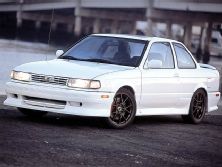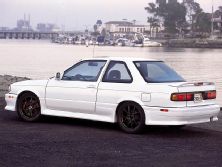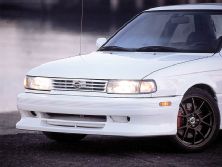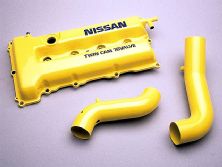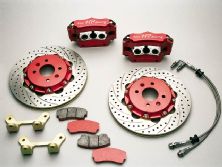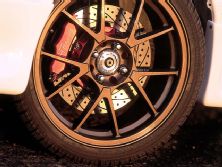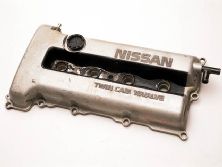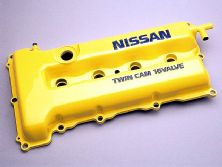Turbo rightfully focuses on sharply tuned engines, honed suspensions and artful interiors in cars that dominate the street and strip. But what about the forgotten ones, cars that haven't seen the pavement in some time? While Supras are the rage, what about more affordable propositions?
The classic Sentra SE-R (1991-1994) is just such a proposition. The sporty two-door coupes can be had for as little as $1,500 in barely running order or less in poor condition. But these cars are still relevant. You get a 2.0-liter SR20DE engine, rated at 140 hp and 132 lb-ft of torque, four-wheel disc brakes, a snappy five-speed stick and available ABS in a fairly lightweight package.
Code Phoenix is my own 1991 classic and as a project car, it has lived a charmed life. I bought it new after landing my first real job 18 days after graduating from college--an editorial assistant position at what was then Petersen Publishing's Sport Truck magazine. I knew nothing of any import performance revolution; it was 1991, which is damn near the first stanza in the evolution of what's now an industry all its own.
Many wondered why I didn't drive a pickup, but I wanted a fast car; I wanted fuel injection and I had no money. I test drove a Civic and an Escort GT, but when I got behind the wheel of the all-new SE-R, I knew I had found a winner before I even got out of the parking lot.
A year and half or so later, I was at Turbo and the Sentra became the first turbocharged variant of the SE-R. It was boosted for five years or so and then taken back to stock by installing a $500 used engine. That junkyard powerplant was massaged with some bolt-ons, including aggressive cams. I had also put 17-inch wheels on the car and noticed the brakes were not as grippy as before.
I soon found myself driving the magazine's long-term Nissan Maxima SE, followed by a Lexus IS300. The SE-R sat. It was fired up occasionally, but it ran roughly and exhibited some typical SE-R gremlins. The brakes were getting worse and worse, raising safety issues. On the road, the engine ran fine, but when applying the clutch, it would stall; re-engaging the clutch would bring back the engine and it would idle in traffic only when the gas pedal was feathered. The culprit was the AAC (idle air control valve assembly).
Two high school-aged kids saw the car in my driveway and made offers. (Odd because it was under a Covercraft car cover.) In fact, one took a test drive with his dad and the car stalled; not a good first impression. My plan was to reinvest the SE-R money into a Datsun roadster and add SR20 power.
I later decided to keep the Sentra--it has 57,000 showing on the odometer, the suspension is tight and thanks to the Covercraft car cover, the paint and interior are in prime condition. The roadster project in truth would cost a lot more than what I was asking for the SE-R. Plus, I had bought the Nissan new and over the years drove many crazy supercars, only to get back in the SE-R and like it more. Too much history, I guess.
I kept the car, transitioning it to project car status, which means stocking it out and starting over. The cams were swapped for the stockers, and aftermarket air-filter and header were replaced by OE stuff. The only remaining mod is the HKS exhaust. I don't have the stocker and want the HKS system to remain; it is the best sounding exhaust I've come across for the SE-R.
The accompanying worksheet chart runs down what was done to bring the car back to road-worthiness. All work was performed at SP Engineering. The compression test showed 152-157 across all four cylinders, well within Nissan specs, so the engine is live. Braking is now a strong point, thanks to the HP Racing upgrade, which we featured as an installation story with our "Brake Parts Guide" in the April 2002 issue.
The HP Racing system features 11.5-inch rotors with anodized centers that match the caliper. The rotors are two-piece units constructed from FC30 rotor material. HP Racing employs a six-piston caliper constructed from 7075 T6 billet aluminum. The HP Racing caliper weighs 6 lbs, while the iron OE unit weighs 11 lbs. Overall, the HP Racing system was 3 lbs lighter than the components previously on the car.
We also elected to swap our 17-inch wheels for 17-inch RH Evolution CP-10s from DAZZ Motorsport. While the 17-inchers impact the effective gear ratio due to greater circumference, we can't do a lot about it since we're swapping 17s for 17s with the same size tire. But weight is also a factor and it is a factor we can address.
The CP-10s weigh in at 35 lbs each with tire, while our originals tipped the scales at 44 lbs.
In a future project update, we'll dyno test the Sentra with both wheel/tire combos to illustrate how much of a difference weight alone makes. Beyond the weight, we also like the bronze powdercoat, a welcome departure from the typical silver or chrome approach. The SE-R has a decidedly J-spec aura to it. The RH Evolution CP-10s are wrapped with 205/40ZR-17 Pirelli P7000 SuperSports.
Keeping to this issue's "Body and Soul" theme, the SE-R's sheetmetal was revitalized with the addition of a Stillen aero kit. The body kit previously on the car was custom built around a front-mount intercooler and its Big Mouth aura looks like overkill without a chiller in there. Stillen's kit is much more composed and its urethane construction ensures it's in the game for the long term. The four-piece kit was installed by Derek and Wally Teklak of Body Pros in Garden Grove, Calif. It was painted veil white and customized with a purple pearl clearcoat.
We began our power infusion with an intake system. The SE-R is a deserving car, but unlike Honda offerings from the same period, the Nissan doesn't have many aftermarket parts available.
AEM stepped to the plate with one of its cold-air systems for the 1991-'94 SE-R. This product was dyno tested in our "Dyno Cell" section in the April issue. However, since there was a hiccup with the car as outlined in the May issue's "Backpressure" column, we will re-test the intake in a future installment.
For added visual appeal, the AEM intake pipes and a used valve cover, scavenged from a dismantling yard, were sent to High Performance Coatings Inc. (HPC) for image therapy. These pieces were subjected to HPC's HiPerColor coatings, which is an appearance coating designed to add color and improve corrosion resistance. It offers thermal protection to 350 degrees, which is overkill for this application.
For headers and exhaust pipes, HPC's HiPerCoat is good to 1,300 degress Fahrenheit. When temperatures really climb, HPC's HiPerCoat Extreme is ready to fend off 2,000 degrees for use on turbo manifolds, turbine housings and other exhaust components. This particular coating is only available in gray and semi-gloss black. For our SE-R, we went with yellow and detailed our valve cover with blue to match the plug wires.
Fix injector harnessIn the future, we'll go for more power from the SR20, but are unsure of how extreme we'll get. One of the items on our list is a set of underdrive pulleys from Unorthodox Racing. Stay tuned.
SourcesAEM(310) 484-2322
Body Pros
(714) 539-7104
Covercraft
(800) 4COVERS or ({{{405}}}) 238-9651
DAZZ Motorsport
({{{626}}}) 962-0033
High Performance Coatings (HPC)
(800) 456-4721
HP Racing
(305) 594-7855
SP Engineering
(626) 333-5398
Stillen
(714) 540-9154
Unorthodox Racing
(613) 253-4909

